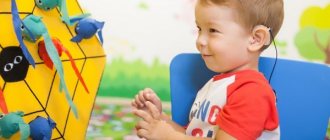When the child begins to coo, the young mother becomes indescribably delighted. Many new parents are really looking forward to this moment; they ask pediatricians and more experienced mothers and fathers about how many months does the child begin to speak his own language, draw out vowels, coo, and coo.
Below we will tell you at what months a child begins to pronounce the first vowels and consonants, and what this event depends on. You will also learn how you can encourage your baby to make feather sounds and what to do if time passes and he is still silent.
It is worth remembering that cooing and humming are different concepts that differ in the set of sounds. When cooing, vowel sounds predominate in speech, and when humming, which appears after 1.5 months, consonant sounds appear in combination with vowels.
Baby's first sounds
The first sounds or when the baby starts to coo? Note that for about the first five weeks you can only hear crying or grunting from the baby. And only by the second month of their life can babies begin to make their very first sounds. Usually the first sounds emitted are vowels that are not difficult to pronounce: a, u, o, e. At the moment of pronouncing these vowels, parents hear the long-awaited “aha”.
The baby begins to coo at 1-2 months, during this period they communicate with themselves, that is, they become familiar with new skills. Children watch the sound source for a very long time, and also try to reproduce it more and more often. Next, they try to apply their skills in communicating with family or toys. Quite often they begin to hum to a melody, which they really like. From the outside it seems that the baby is singing along.
Around the fourth month, babies begin to try to pronounce the first consonants. At first you can hear from them: m, p, b. And then, more and more often, you will hear individual syllables, from which the baby’s babbling gradually begins to form. By the end of the first year, children are already beginning to pronounce their first words, which consist of the same syllables.
When a baby starts babbling
After six months, when the period of babbling begins, the infant’s speech is notable for the single-sounding syllables “ba”, “ta”, “ma”, “pa”. At six months, a child clearly distinguishes intonation, senses your mood, watches your facial expressions, and imitates the sounds of adults’ speech. Emotional sensitivity makes your communication active and versatile.
Only closer to 1 year, syllables will begin to be repeated and formed into simple words. By this time, the baby will have about 10 words in his everyday life, such as “dad”, “mom”, “baba”, “give”, etc. And then the verbal boom is just around the corner - after all, time flies quickly!
Learning to coo
Gurgling is a fairly significant process in the further formation of speech. It is absolutely impossible to specifically teach a baby to walk. But some actions on the part of the parents will definitely help the child quickly begin to communicate with the world that surrounds him.
So, at what months does the baby start to coo, we have almost figured it out. Therefore, now we should highlight certain points that can speed up this process. What parents should do:
- First of all, parents need to communicate with their baby as much as possible. You need to accompany any of your actions with an explanation, that is, tell your baby what you are doing at this very moment. You need to communicate with your baby while changing a diaper, bathing, swaddling, etc. That is, communication should occur while the baby is awake. A conversation between an adult and a child should take place in calm tones, and speech should be affectionate. In no case should you use sharp bursts of hands or a raised tone in a conversation, in this case, you may frighten your child;
- Please note that you need to repeat after the child all his sounds, and also supplement them with new, but simple ones. Children begin to try to repeat what was said. The “ahu” dialogue should take place with the baby and parents, accompanied by a smile, then the baby begins to hum and smile;
- During a conversation, you need to massage the baby's hands with light and gentle movements. It is on the baby’s hands that there are points that are associated with areas of the brain that are responsible for the development of speech. Also, these manipulations can develop fine motor skills in the baby.
When communicating with a newborn, you should not distort words, as they will not hear the correct pronunciation, which in turn can harm the further development of speech. Try to read short poems, folk jokes, etc. to your baby as often as possible. Such actions will contribute to active development.
What to do if the baby is stubbornly silent
In a situation of stubborn silence, it is important to get specialist advice and eliminate the risk of health problems. The baby should be provided with the proper level of comfort. A happy and fed child who does not experience problems with health and care will soon begin to walk again.
It is required to spend a lot of time communicating with the child, accompanying all actions performed with him with speech, nursery rhymes, and songs. The baby understands perfectly well that adults are communicating with him at such a moment and will strive to give a response.
The baby is a month old and he is still silent
There is no need to worry if a newborn is not cooing by the end of the first month, because they are not mechanical devices in which the pace of development is set. That is, every baby develops as he needs. At how many months does a baby start to coo is a very individual question. One baby begins to try to pronounce “aha” already at three weeks, while the other is still silent, but he will begin to delight others with pleasant sounds a little later. Silence may be due to the fact that the child will be silent by nature.
There are also cases when the baby began to gurgle quite early, but then suddenly fell silent. You shouldn’t stress yourself out and worry, as the baby is simply beginning the period of preparation for the next portion of speech skills. After a certain period of time, the hooting will return, but accompanied by laughter, squeaking and squealing. It also happens that sudden silence can be caused by a number of certain factors, for example, due to stress or poor health.
If your child is silent for a long time, you should seek help from a pediatrician. You should start worrying after eight months. Perhaps the baby has developed some problems with neurology or with the hearing aid. The pediatrician should refer the child to a specialist, for example, a neurologist or otolaryngologist, to determine the causes of delayed speech development and their treatment.
Reasons for the lag
If the baby is silent, repeats the same type of sounds, or lags significantly behind his peers (more than 4-5 months for boys and 2-3 for girls), then he is diagnosed with delayed speech development.
The reasons are medical and social:
- neurological disorders that arose against the background of hypoxia, asphyxia, difficult childbirth, infectious processes, brain injuries;
- deep prematurity;
- suffered severe infectious diseases;
- hearing loss;
- lack of communication;
- mental trauma;
- uncertainty of hand dominance (right-handedness or left-handedness);
- heredity.
How is cooing different from humming?
When babies begin to coo and gurgle, parents experience a lot of joyful sensations. Gurgling is the sound of vowel sounds from a child's mouth, and humming is a speech form that is more complex.
Consonants begin to appear in sounds, for example: g, k, x in combination with vowels. Then you can hear: agu, ky, khy, gu. The walking stage can last up to four or five months. Sometimes these sounds arise spontaneously in a baby, for example, when studying a toy. However, gradually the baby will begin to use humming and cooing in response to communication or a smile from a loved one.
During the period when the baby begins to communicate, parents should understand that this is a rather important stage in the timely and correct development of the child. Three months are considered to be the peak of the boom. This is exactly the age when you should have a camera at hand so that you always have the opportunity to film the baby’s unique songs. Very often, newborns begin to hum along to certain songs, it turns out as if the baby is singing along.
If a child begins to coo and wail, and then stops
If the baby starts to gurgle, but after a while becomes silent, then there is no need to worry. This break may be required to improve speech, for example, to master syllables. The crowing resumes, but it is no longer the same as before, but more intense, with intonation.
Sometimes the reason for stopping partying can be severe stress, fear, or neurological disorders. If you do not help the child, this becomes the cause of delayed speech development.
To resume croaking, you need to show the baby to a pediatrician, and then, if necessary, to a neurologist or ENT specialist. If there are no deviations, then active communication, massage, and games will help.
All infants gurgle because they do not yet know how to talk. This is preparation for speech, so maximum attention should be paid to its development.
Photo: ru.freepik.com
Speech development of a baby up to six months
We have already studied at what age the baby begins to gurgle, but now it is worth paying attention to what kind of help should be received from parents:
- Constantly communicate with your child. Try to convey to him everything that you do. Speech should be as calm, gentle and clear as possible. Under no circumstances should you raise your voice at your newborn.
- In your stories you should show your emotions, gestures and facial expressions. But do not make any sudden movements so as not to scare the baby. The child will begin to happily repeat the movements of lips, words and sounds after adults. Remember that kids watch all your movements.
- For educational activities, prepare cards with colorful pictures. Explain to the child what is depicted on them.
- Repeat the sounds your baby uses and add new ones.
- Play music and animal sounds for your child.
By six months, the baby will learn to consciously smile and coo; these skills are developed in the child through activities with parents. Give your baby as much attention as possible.
Sources
- Wu Y., Li G., Zheng Y. . // Lin Chung Er Bi Yan Hou Tou Jing Wai Ke Za Zhi - 2021 - Vol35 - N4 - p.341-345; PMID:33794634
- Karcher NR., Loewy RL., Savill M., Avenevoli S., Huber RS., Simon TJ., Leckliter IN., Sher KJ., Barch DM. Replication of Associations With Psychotic-Like Experiences in Middle Childhood From the Adolescent Brain Cognitive Development (ABCD) Study. // Schizophr Bull Open - 2021 - Vol1 - N1 - p.sgaa009; PMID:32803159
- Skovlund E., Selmer R., Skurtveit S., Brandlistuen RE., Handal M. In utero exposure to analgesic opioids and language development in 5-year old children. // Pharmacoepidemiol Drug Saf - 2021 - Vol29 - N6 - p.736-744; PMID:32383248
- Yi YG., Lee DW., Kim J., Jang JH., Lee SM., Jang DH. Two Novel Mutations (c.883-4_890del and c.1684C>G) of WDR62 Gene Associated With Autosomal Recessive Primary Microcephaly: A Case Report. // Front Pediatr - 2021 - Vol7 - NNULL - p.457; PMID:31788460
- Llaci L., Ramsey K., Belnap N., Claasen AM., Balak CD., Szelinger S., Jepsen WM., Siniard AL., Richholt R., Izat T., Naymik M., De Both M., Piras IS., Craig DW., Huentelman MJ., Narayanan V., Schrauwen I., Rangasamy S. Compound heterozygous mutations in SNAP29 is associated with Pelizaeus-Merzbacher-like disorder (PMLD). // Hum Genet - 2021 - Vol138 - N11-12 - p.1409-1417; PMID:31748968
- Wu Y., Li G., Ma Y., Zheng Y. . // Lin Chung Er Bi Yan Hou Tou Jing Wai Ke Za Zhi - 2021 - Vol33 - N10 - p.918-922; PMID:31623034
- Botticelli S., Küseler A., Mølsted K., Andersen HS., Boers M., Shoeps A., Emborg BK., Kisling-Møller M., Pedersen TK., Andersen M., Willadsen E. Influence of Infant Cleft Dimensions on Velopharyngeal Function in 5-Year-Old Danish Children Born With Unilateral Cleft Lip and Palate. // Cleft Palate Craniofac J - 2020 - Vol57 - N4 - p.420-429; PMID:31505955
- Salvago P., Gorgone E., Giaimo S., Battaglia E., Dispenza F., Ferrara S., Martines F. Is there an association between age at first words and speech sound disorders among 4- to 5-year-old children ? An epidemiological cross-sectional study based on parental reports. // Int J Pediatr Otorhinolaryngol - 2021 - Vol126 - NNULL - p.109602; PMID:31374388
- Ingram SB., Reed VA., Powell TW. Vowel Duration Discrimination of Children With Childhood Apraxia of Speech: A Preliminary Study. // Am J Speech Lang Pathol - 2021 - Vol28 - N2S - p.857-874; PMID:31306605
- Dawes E., Leitão S., Claessen M., Lingoh C. Oral literal and inferential narrative comprehension in young typically developing children and children with developmental language disorder. // Int J Speech Lang Pathol - 2021 - Vol21 - N3 - p.275-285; PMID:31159597








